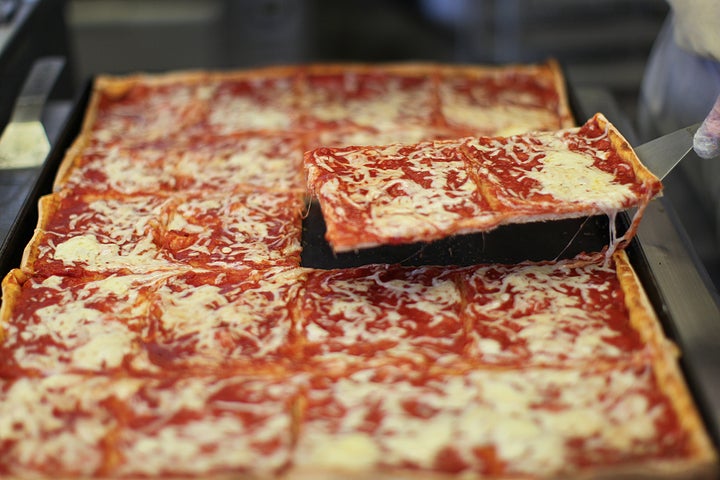If visions of pizza transport you instantly to a slice joint in New York City’s West Village, well, you’re not entirely to blame. The Big Apple is famous for many things, not the least of which is the singe-the-skin-from-your-palate-hot pizzeria slice. But if you thought that New York was a one-stop destination for the finest carbohydrate delights on the Eastern Seaboard, you may have missed a state or two in passing.
To the north, New England — particularly Massachusetts, New Hampshire and Connecticut — boasts distinct, lovely and cultishly adored styles of pizza. In Connecticut, the New Haven pie, a coal-fired, charred pie made famous by Sally’s Apizza and Frank Pepe Pizzeria Napoletana, has been turning heads since the early 20th century. Rhode Islanders, inspired by chefs Johanne Killeen and George Germon at Providence’s Al Forno, which opened in 1980, grill their pies. Greek-style pizza, the noble home of which is in Massachusetts, comes in the form of impossibly thick-crusted pies, as any Bay Stater knows. And the New Hampshire border towns produce a very specific, sweet-sauced specimen known as beach pizza, sold by the Provolone-draped slice.
New England may not be first on your list of pizza destinations, but New Englanders have long harbored a passion for carbohydrate-rich delights. Consider the dedication to fried clams, or ice cream. In New Haven, Wooster Street is where you’ll find world-class pies, first at the 81-year-old Sally’s Apizza and, just down the street, at the 94-year-old Frank Pepe Pizzeria Napoletana.
“My grandfather was born in a small town just southwest of Naples, Italy, and came over to the United States in 1909, when he was just 16 years old,” said Gary Bimonte, co-owner of Frank Pepe Pizzeria Napoletana and grandson of founder Frank Pepe. “My grandparents were passionate about creating a product that highlighted family tradition and loyalty, and that’s why we still make that same product today.”
Bimonte’s grandparents married in 1919 and opened a bakery to start, before changing subject matter. Eventually, their famous pizzas were born. They started with two signature pies: one using tomatoes, grated cheese, garlic, oregano and olive oil, called the Original Tomato Pie, and a second, using anchovies.
Eventually, seizing on popularity, they added additional ingredients. Nearly a century later, the pizzas are as popular as ever, with lines snaking around the block. Bimonte defines the New Haven style as pizza with “a thin, crisp, charred and chewy crust,” and a sauce made from imported Italian plum tomatoes.

“Our legendary White Clam Pie is a must-try,” Bimonte added, “along with our Original Tomato Pie. Both of these pies were created by my grandfather, and their recipes are built on tradition to this day, as my family feels it’s important to keep his legacy alive.” Coal, he said, is an important distinction, since it burns hot and doesn’t give off steam the way wood does. The result is a crispier pizza with more char around the edges.
Not everyone up north prefers their pizza thin — and New England is certainly not uniform when it comes to pizza style. In Massachusetts, the phenomenon of Greek-style pizza chains is known to anyone who grew up in the Bay State. Owned by Greek families and possessed by fork-and-knife-required thick crusts, these are heavy pizzas, preferred by many. If you grew up eating at places with names like Ipswich House of Pizza, or The Pizza Factory or just Nick’s, you likely have a certain nostalgia for Greek pizza, which isn’t necessarily good as much as it is dependable. Its utter sameness, no matter where you get it, is one of those things that brings great comfort in times of unpredictability.
The same is true for another New England pizza tradition, this one along the New Hampshire-Massachusetts border. Beach pizza is also a Greek tradition, but, unlike its southern cousins, it’s baked off in square sheet trays, topped with sweet sauce and heated to order with a circle of palate-searing provolone. It is served near the beach — the beach that borders Massachusetts and New Hampshire, to be clear — and while there are notable purveyors (Tripoli Pizza Bakery, Cristy’s) who sell it, the blanket term for this type of specialty pizza among locals is just: beach pizza. It is beloved. It is sacred. It is not seasonal, despite the moniker.

Grilled pizza, the provenance of Providence, also is not seasonal, despite the association with grilling season, or summer. Before James Beard Award-winning chefs Killeen and Germon opened their Rhode Island restaurant Al Forno, they lived in Italy.
“We fell in love and started wooing each other with the food we loved in Italy. We were crazy about each other and our mutual love of Italy,” Killeen said. “The grilled pizza is the brainchild of my late husband. It came about by a simple mistake. A friend told him he had just returned from Italy and had grilled pizza. This man was not a cook and didn’t know the difference between an oven and a grill. He saw flames and called it a grill.” Grilled pizza? Idea in hand, Germon, Killeen said, was off and running.
Together, they made the dough and put it on the grill. It was the early 1980s. The restaurant had opened not long before. “We had no idea it would become such a sensation,” she said. “It is our most popular dish and has been for nearly 40 years.” Natural wood creates a hot fire that is extremely important for the char on the dough.

The dough itself consists of yeast, flour, salt and water. Killeen is spare with her toppings. “They will not cook on top of the dough,” she said.
“A very good virgin olive oil is essential to the taste. The texture of the crust should be chewy in parts and a little crispy in other parts, where the fire is more intense.” The process takes only a handful of minutes from the time the dough hits the fire. She describes the finished product as a thin-crusted, smoky pizza that is “almost indescribably delicious.”
That singular idea has captivated Rhode Islanders, who now view grilled pizza as part of their cultural heritage. Of course, each sub-region has its own take on pizza, its own peccadilloes. There is no reigning style that defines pizza in New England, no single aesthetic — but that’s what keeps things interesting. It is a region without rules. Would New Englanders have it any other way?
